Emission Nebulae
M17 - Swan Nebula
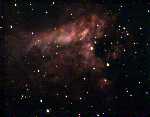 |
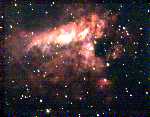 |
| Imax=50 | Imax=20 |
50 exposures, 10s each 9/26/08 Lake San Antonio, CA
This was one of the easier targets, because it is bright and just the right size to fit into the camera's field of view. You can see the "swan" if you rotate by 180 degrees. Note the interesting dark clouds near the top edge, and the red and blue patches close to each other a little bit above the brightest star near the center. There seems to be a little bit of tracking error or something, judging by the elongated star images.
M16 - Eagle Nebula
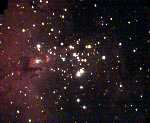 |
 |
| Imax=20 | Imax=200 |
18 exposures, 30s each 9/25/08 Lake San Antonio, CA
M16 contains both an open cluster and the Eagle nebula, including the "pillars of creation" from the famous Hubble picture. Visually, we saw the open cluster and some faint glow from the nebula, but did not spot the pillars. Perhaps we could try again, now that we know what to look for...
M42 - Orion Nebula
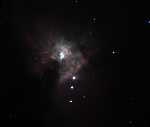 |
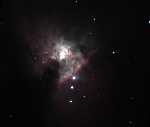 |
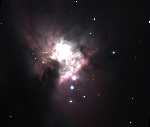 |
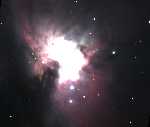 |
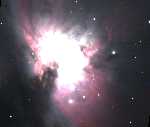 |
| Imax=1500 | Imax=1000 | Imax=500 | Imax=250 | Imax=150 |
33 exposures, 10s each 9/26/08 Lake San Antonio, CA
As with M31, this object presents a huge range of brightnesses, so 5 different intensity scalings are shown here. Such beautiful colors!
M20 - Trifid Nebula
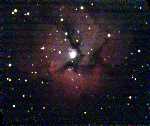 |
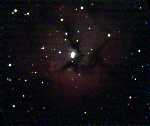 |
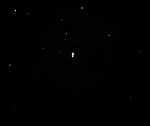 |
| Imax=25 | Imax=50 | Imax=1000 |
21 exposures, 10s each 9/27/08 Lake San Antonio, CA
This could use a lot more exposure, but the colors are already very nice. The focus might be a little off, or maybe it was too low in the sky.
M8 - Lagoon Nebula
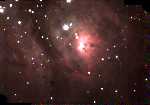 |
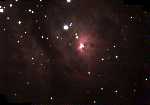 |
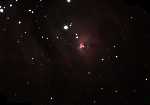 |
| Imax=50 | Imax=100 | Imax=200 |
110 exposures, 10s each 9/27/08 Lake San Antonio, CA
The focus here is not ideal - also it was very low in the sky. More than one image scaling is needed to show both the hourglass feature in the brightest part of the nebula, and the fainter structure that fills the rest of the image.
Planetary Nebulae
M57 - Ring Nebula
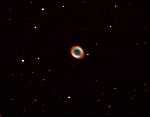 |
| see notes |
1 exposure, 60s 6/6/08 San Jose, CA
This is one of my first attempts at a deep sky object. This is a single exposure, processed using the MaxIm Essentials software that came with the camera. Therefore, the color conversion is different from the majority of images displayed here.
M27 - Dumbbell Nebula
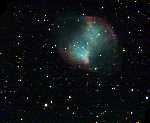 |
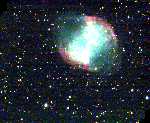 |
| Imax=30 | Imax=10 |
18 exposures, 30s each 9/25/08 Lake San Antonio, CA
Visually, we could see only a little bit of structure, and no color.
NGC 6445
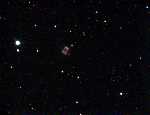 |
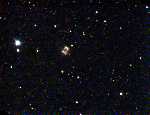 |
| Imax=40 | Imax=20 |
12 exposures, 30s each 9/26/08 Lake San Antonio, CA
Kathy chose this planetary nebula in Sagittarius as a target, to make sure we looked at more than just the well-known showpiece objects. Visually we could tell that it was ring-like, and it shows some interesting color.
NGC 7662 - Blue Snowball
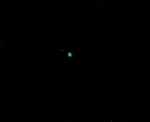 |
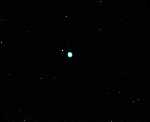 |
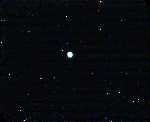 |
| Imax=860 | Imax=200 | Imax=50 |
39 exposures, 10s each 9/27/08 Lake San Antonio, CA
Visually, we did not see any structure, just a blue blob. However, an interesting feature can be seen in the full-scale (Imax=860) image.
NGC 7009 - Saturn Nebula
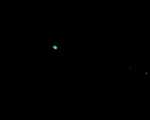 |
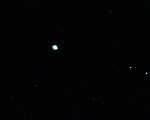 |
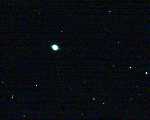 |
| Imax=1100 | Imax=200 | Imax=50 |
20 exposures, 10s each 9/27/08 Lake San Antonio, CA
This planetary nebula has some interesting inner structure (can be seen only in the Imax=1100 image with full intensity scale) in addition to the faint rays ("ansae") for which this object is named.
M97 - Owl Nebula
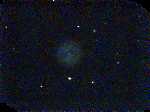 |
| Imax=20 |
46 exposures, 10s each 12/29/08 Phoenix, AZ
This object is faint, but it appears to have a green color. I ended up with a small number of exposures here due to wind problems.
Supernova Remnants
M1 - Crab Nebula
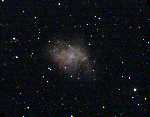 |
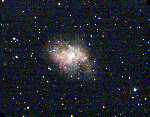 |
| Imax=20 | Imax=10 |
13 exposures, 30s each 9/25/08 Lake San Antonio, CA
This is the famous supernova remnant in Taurus. The surface brightness is rather low, and it is difficult to see any structure visually. This object could benefit from more (or longer) exposures, but already the main features (red filaments and green/gray diffuse glow) are apparent.
NGC 6992/5 - Veil Nebula (east half)
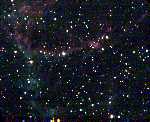 |
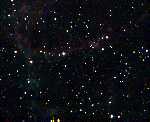 |
| Imax=10 | Imax=20 |
8 exposures, 30s each 9/25/08 Lake San Antonio, CA
Supernova remnant. Only a small portion can fit into the camera field of view at a time. This object could use a lot more exposure.
NGC 6960 - Veil Nebula (west half)
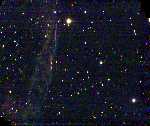 |
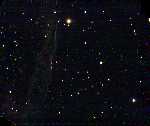 |
| Imax=10 | Imax=20 |
12 exposures, 30s each 9/25/08 Lake San Antonio, CA
Another portion of the Veil nebula, near 52 Cygni (outside of field of view).
Globular Clusters
M13 - Hercules Cluster
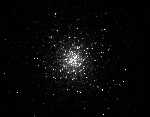 |
| see notes |
9 exposures, 10s each 6/6/08 San Jose, CA
This was one of my first attempts at a deep sky object. 9 images were combined using the MaxIm softare that came with the camera. In the process, the color information was lost, so this is a black-and-white image.
M22
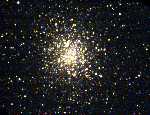 |
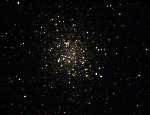 |
| Imax=50 | Imax=200 |
16 exposures, 10s each 9/27/08 Lake San Antonio, CA
This is a nice globular cluster but was rather low in the sky. Most of the images were blurry, but some were relatively clear. To obtain this image, only the best 16 out of 52 exposures were combined.
NGC 6440
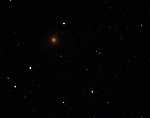 |
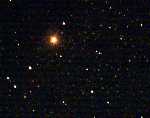 |
| Imax=100 | Imax=20 |
5 exposures, 30s each 9/26/08 Lake San Antonio, CA
This is a globular cluster in the same eyepiece field as NGC 6445. The orange color is real-- apparently there is a lot of galactic dust obscuring this object.
NGC 6440
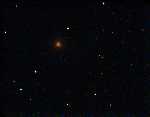 |
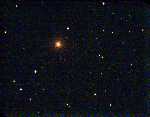 |
| Imax=100 | Imax=40 |
23 exposures, 10s each 9/26/08 Lake San Antonio, CA
Another image of NGC 6440, but shorter exposures... better resolution but less signal.
Galaxies
M31 - Andromeda Galaxy
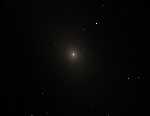 |
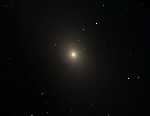 |
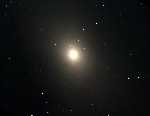 |
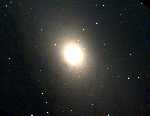 |
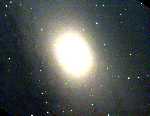 |
| Imax=480 | Imax=240 | Imax=120 | Imax=60 | Imax=30 |
55 exposures, 10s each 9/26/08 Lake San Antonio, CA
Only a small portion of M31 can fit in the field of view. There are interesting features over a large range of brightnesses, so many intensity scalings are needed to show the true nature of this object. There is a very small and bright central core, and near the core there are intersting dark features (dust clouds). Towards the other bands there are many more dark clouds with a lot of structure.
M31 - Andromeda Galaxy
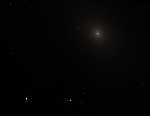 |
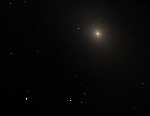 |
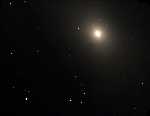 |
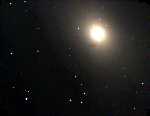 |
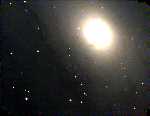 |
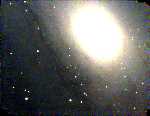 |
| Imax=640 | Imax=320 | Imax=160 | Imax=80 | Imax=40 | Imax=20 |
113 exposures, 10s each 9/26/08 Lake San Antonio, CA
Same as above, but centered on the main dark lanes.
M31 - Andromeda Galaxy
 |
 |
 |
 |
 |
| Imax=30 | Imax=60 | Imax=120 | Imax=240 | Imax=480 |
31 exposures, 10s each 01/01/09 Phoenix, AZ
Here's another set of M31 taken with Jim on New Year's Day.
M33 - Triangulum Galaxy
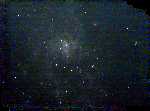 |
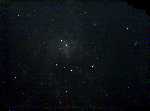 |
| Imax=20 | Imax=40 |
97 exposures, 10s each 9/26/08 Lake San Antonio, CA
Like the Andromeda Galaxy, this galaxy is much too large to fit inside the field of view, but it is much more challenging bceause of its low surface brightness. However, there is a much better chance to see individual stars, clusters, and nebulas. This image just shows the central portion. A much longer exposure is needed to really show all of the features in this galaxy.
NGC 604 in M33
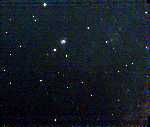 |
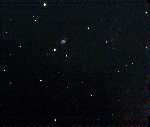 |
| Imax=20 | Imax=40 |
60 exposures, 10s each 9/26/08 Lake San Antonio, CA
This is another image of the Triangulum Galaxy, but shifted to the upper-left to show the most prominent nebula in this galaxy, NGC 604. It does not have the red color I expected from photographs I have seen. I'm not sure why, but I notice it also appears smaller than what I saw in some photographs, so perhaps we are seeing only the brightest core of the nebula due to insufficient exposure.
NGC 7331
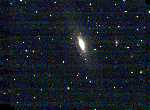 |
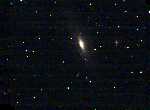 |
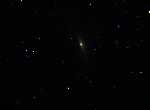 |
| Imax=10 | Imax=20 | Imax=100 |
14 exposures, 30s each 9/25/08 Lake San Antonio, CA
This is the same galaxy that appears on the cover of the 2008 Observer's Handbook, but that cover image appears as a mirror image compared with the images shown here. I'm pretty sure that my image is the correct one! As with M31, there is a bright central core, dust lanes, and faint outer arms, but the general appearance is a bit different.
M51 - Whirlpool Galaxy
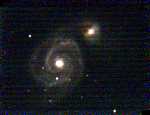 |
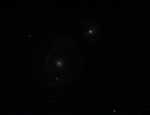 |
| Imax=10 | Imax=100 |
13 exposures, 30s each 9/25/08 Lake San Antonio, CA
Out of focus - it was very low in the sky when we took these images so I don't know if we could have done better. We'll have to try this one again in the right season.
M81
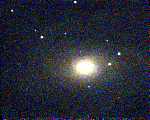 |
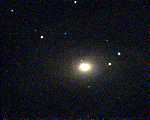 |
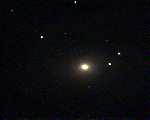 |
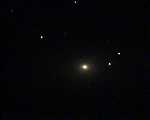 |
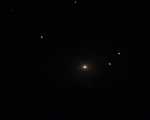 |
| Imax=15 | Imax=30 | Imax=60 | Imax=120 | Imax=240 |
32 exposures, 10s each 12/28/08 Phoenix, AZ
This should have been a good target, but I was having a lot of trouble with wind shaking the scope. I was only able to use about half of total exposures.
M81
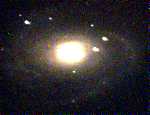 |
| Imax=7.5 |
4 exposures, 60s each 12/28/08 Phoenix, AZ
Here, a few longer exposures are used to show the faint arms better, though the stars are blurred by the scope shaking combined with poor tracking.
M82
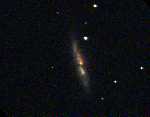 |
| Imax=50 |
18 exposures, 10s each 12/28/08 Phoenix, AZ
These images also suffered from wind and shaking, reducing the resolution I could get. There is some interesting color apparent, though.
Nearby Stars
Barnard's Star
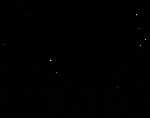 |
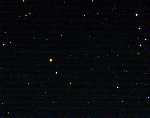 |
| Imax=1000 | Imax=100 |
6 exposures, 10s each 9/25/08 Lake San Antonio, CA
This is the second-closest star system to our own, and the closest one that is observable from our latitude. This is a red dwarf star, with only 1/2500th the luminosity of the Sun. Distance: 5.94 ly (compared with 4.22 ly for Proxima Centauri). Magnitude: 9.54. Spectral type: M5. In this image, it is the bright orangish spot to the left of center.
Barnard's Star
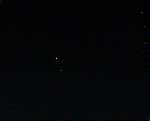 |
| Imax=1000 |
52 exposures, 1s each 9/25/08 Lake San Antonio, CA
Same as above except for shorter exposure.
Barnard's Star, 3X
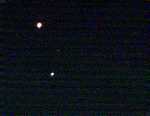 |
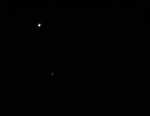 |
| Imax=50 | Imax=500 |
6 exposures, 10s each 9/25/08 Lake San Antonio, CA
This image was obtained using a 3X Barlow to get the best possible resolution as needed for a parallax measurement. The elongation is probably due to tracking errors.
Barnard's Star, 3X
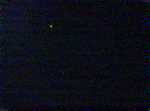 |
| Imax=500 |
59 exposures, 1s each 9/25/08 Lake San Antonio, CA
Also with 3X Barlow, shorter exposures. Again there is some elongation, but at least the disk is smaller. It might be possible to do better with some changes to the image processing, by rejecting images with large spot sizes, or by processing the different colors separately.
61 Cygni, 3X
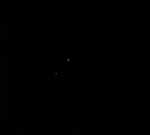 |
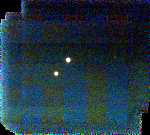 |
| Imax=50000 | Imax=500 |
295 exposures, 0.1s each 9/27/08 Lake San Antonio, CA
61 Cygni is a magnitude 5 double star in Cygnus, famous for being the first star whose parallax was measured. This was accomplished by F. W. Bessel in 1838 using visual observation techniques, before photography existed! Distance: 11.4 ly. Individual magnitudes (A,B): 5.20, 6.05. Luminosities: only 0.065 and 0.038 compared with the Sun. Spectral types (A,B): K5, K7. The image here, obtained using a 3X Barlow, shows some color separation problems that I have noticed before with this camera. These effects tend to occur with very short exposures, especially if the object moves. Also, I cannot rule out that the Barlow could be causing some color effects.
61 Cygni, 3X
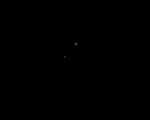 |
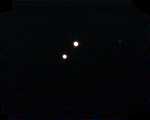 |
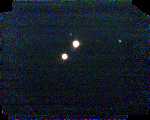 |
| Imax=25000 | Imax=500 | Imax=100 |
198 exposures, 1s each 9/27/08 Lake San Antonio, CA
Same as above but longer exposures. The background stars (needed for parallax measurement) are brighter, but the price is saturation and enlargement of the 61 Cygni disks.
61 Cygni, 3X
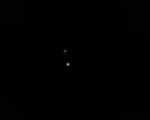 |
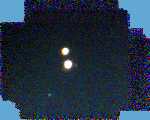 |
| Imax=5000 | Imax=50 |
821 exposures, 1s each 12/29/08 Phoenix, AZ
The resolution here is a lot worse than in my previous sets. To compensate, I took a huge number of exposures in hope that it will still be possible to estimate the star center positions with < 1 arcsec accuracy.
Epsilon Eridani
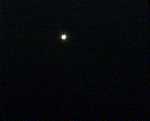 |
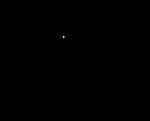 |
| Imax=500 | Imax=10000 |
59 exposures, 1s each 9/25/08 Lake San Antonio, CA
This is another nearby star. Distance: 10.5 ly. Magnitude: 3.7. Luminosity: 1/3 that of the Sun. Spectral type: K2. In this 1s exposure, the star image is already saturated, and yet there are very few background stars. This will make it difficult to attempt a parallax measurement. With the 3X Barlow, I doubt I could get any background stars without completely over-exposing the main target.
Epsilon Eridani
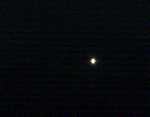 |
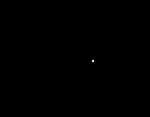 |
| Imax=500 | Imax=10000 |
59 exposures, 1s each 9/25/08 Lake San Antonio, CA
Same as above, shifted.
Epsilon Eridani
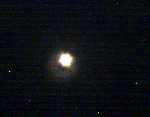 |
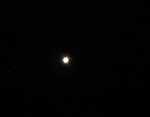 |
| Imax=50 | Imax=500 |
13 exposures, 10s each 9/25/08 Lake San Antonio, CA
Same as above, but longer exposure. Now there are more background stars, but epsilon is completely over-exposed.
Lalande 21185
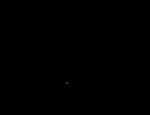 |
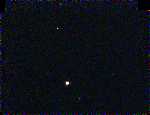 |
| Imax=10000 | Imax=100 |
297 exposures, 1s each 12/29/08 Phoenix, AZ
This is another good candidate for a parallax measurement. It is called BD +36°2147 in the Observer's Handbook. It is 8.31 light years distant, is visible most of the year, and is not too bright relative to the background stars.
Planets
Venus
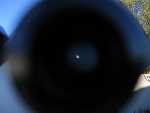 |
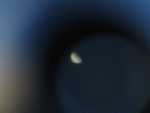 |
| zoomed out | zoomed in |
Pointing digital camera into eyepiece 1/1/09 Phoenix, AZ
I found Venus during the day and wanted to take a picture of it, but even the blue sky alone was too bright for the shortest exposures of the Orion Starshoot. Instead, I got these pictures by pointing a digital camera into the eyepiece. This was actually difficult because it is not possible to get much of the field view of the eyepiece into the camera's lens system, even with the lens right up against the eyepice. The size of Venus on this day should have been about 22 arcsec.
Jupiter
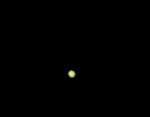 |
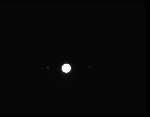 |
| 0.02s+moon | 0.1s |
Short exposures 5/31/08 Sunnyvale, CA
These were my first attempts at Jupiter. It saturates even for the shortest possible exposures, so I used a "moon" filter for the 0.02s exposure which unfortunately also messes up the color (it adds a greenish tint). The longer exposure (without the "moon" filter shows the 4 moons of Jupiter.
Jupiter, 3X
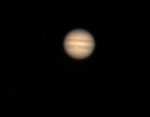 |
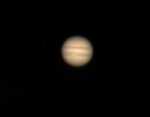 |
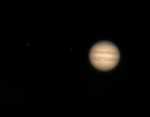 |
| try 1 | try 2 | try 3 |
60 exposures, 0.02s each 7/13/08 Sunnyvale, CA
These are the first Jupiter attempts using a 3X Barlow lens. In each set, 60 separate images were combined using a somewhat different method from the one used on all of the deep sky images above. Although the resolution is not great, the red spot is obviously there.
Jupiter, 3X, deconvolved
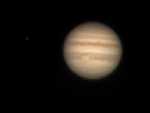 |
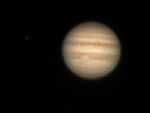 |
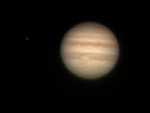 |
| try 1 | try 2 | try 3 |
60 exposures, 0.02s each 7/13/08 Sunnyvale, CA
Attempted deconvolution of the above images using a Richardson-Lucy routine implemented in Matlab.
Jupiter, 3X
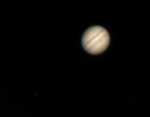 |
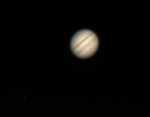 |
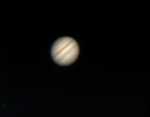 |
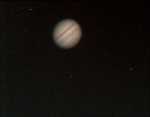 |
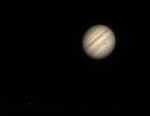 |
| #1: 60x0.02s | #2: 60x0.02s | #3: 60x0.05s | #5: 10x1s | #1, deconvolved |
8/8/23 Sunnyvale, CA
Another attempt on Jupiter. Seeing was OK, but clouds moved in after 20 minutes. In image #5, there were already fairly thick clouds covering Jupiter. The colorful little artifacts are not parachuting aliens, but rather are due to hot pixels. Normally these would be removed, but no dark subtraction or bad pixel removal was done for this sequence.
Saturn
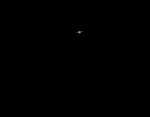 |
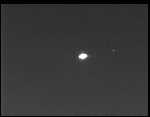 |
| 1 x 0.02s | 60 x 0.02s |
0.02s exposures 6/1/08 Sunnyvale, CA
These are my first and only attempts at Saturn, before I had the Barlow lens.